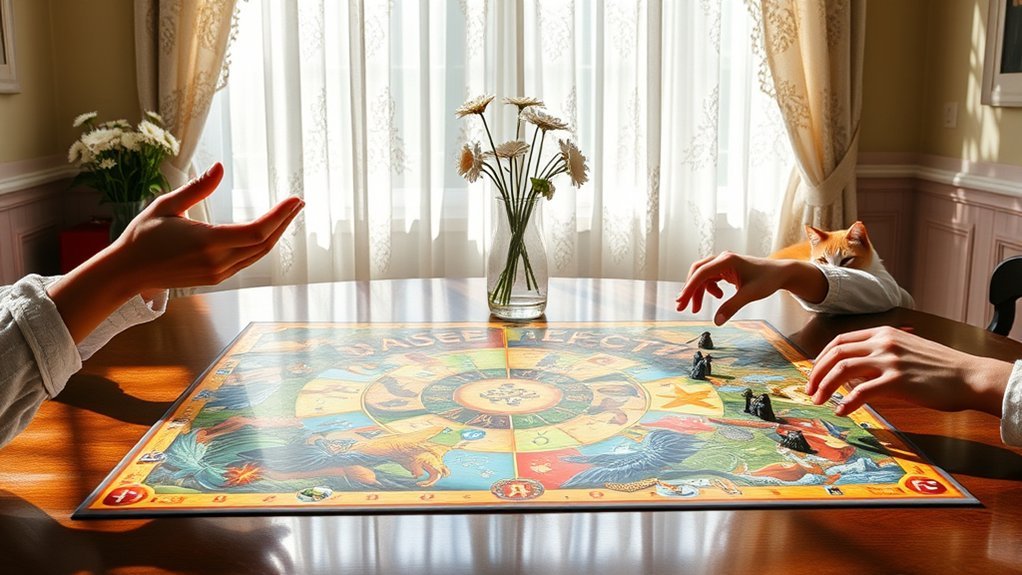You might think cause and effect play is just child’s play, but it’s actually a cornerstone of learning. Many believe it only benefits young kids or serves merely as entertainment, but that couldn’t be further from the truth. This type of play shapes critical thinking and problem-solving skills at all ages. So, what’s the real story behind it? The answer might surprise you as we explore the myths and facts surrounding this essential aspect of development.
Understanding Cause and Effect Play
When you plunge into the world of cause and effect play, you’ll quickly discover its fundamental role in child development. This type of play helps children understand relationships between actions and outcomes, fostering critical thinking and problem-solving skills.
For example, when a child drops a toy and observes it fall, they begin to grasp the concept of gravity. Research indicates that engaging in this play enhances cognitive abilities, as children learn to predict and manipulate their environment.
Furthermore, cause and effect play promotes emotional growth; children experience satisfaction from seeing their actions lead to desired results. By facilitating this type of exploration, you’re not just encouraging play—you’re laying the groundwork for essential life skills that will benefit them throughout their development.
Common Myths Surrounding Cause and Effect Play
Cause and effect play is often surrounded by a haze of misconceptions that can obscure its true value in child development. Many believe that this type of play is merely about entertainment, but it’s actually foundational for cognitive growth.
Some think it only benefits younger children, overlooking how older kids continue to refine their understanding of cause and effect through more complex play scenarios.
Another myth is that all cause and effect play is the same; in reality, different types, like physical or social play, contribute uniquely to a child’s learning.
The Science Behind Cause and Effect Learning
Understanding the foundations of cause and effect play goes hand in hand with recognizing the science behind how children learn from these interactions. As kids engage in activities where their actions produce outcomes, they form neural connections that enhance cognitive development.
Research shows that these experiences help them grasp the relationship between actions and consequences, fostering critical thinking skills. When you allow your child to explore this play, they’re not just having fun; they’re actively constructing knowledge.
This learning process involves trial and error, reinforcing the idea that mistakes are valuable steps toward understanding. By providing opportunities for cause and effect exploration, you’re supporting their natural curiosity and helping them develop essential reasoning skills that will benefit them throughout life.
Benefits of Cause and Effect Play for Cognitive Development
While engaging in cause and effect play, children open up a range of cognitive benefits that greatly enhance their developmental journey. This type of play not only sparks curiosity but also lays the groundwork for critical thinking skills.
You’ll notice your child developing essential abilities as they explore the consequences of their actions.
- Enhances problem-solving skills by encouraging experimentation.
- Boosts memory through repeated cause-and-effect scenarios.
- Fosters creativity as children invent new ways to interact with objects.
- Strengthens understanding of logical sequences and relationships.
Creating Engaging Environments for Cause and Effect Exploration
Creating a stimulating environment for cause and effect exploration is key to maximizing the cognitive benefits your child gains during play. Think about incorporating diverse materials like blocks, water, and sand. These elements encourage experimentation and curiosity, allowing your child to see how actions lead to reactions.
Set up spaces that invite interaction; for instance, use ramps for rolling objects or containers for pouring. Research shows that children learn best through hands-on experiences.
Ensure the environment is safe yet challenging, promoting problem-solving and critical thinking. As your child navigates these activities, they’ll develop a deeper understanding of cause and effect.
Frequently Asked Questions
What Age Is Best for Introducing Cause and Effect Play?
You can introduce cause and effect play around 6 months old. At this age, babies start exploring actions and reactions, so engaging them with simple toys encourages curiosity and cognitive development essential for future learning.
Are There Specific Toys That Enhance Cause and Effect Learning?
Absolutely, you’ll find that toys like stacking blocks, musical instruments, and interactive games greatly enhance cause and effect learning. They engage curiosity, encourage experimentation, and nurture critical thinking, fostering essential cognitive skills in a delightful way.
How Can Parents Encourage Cause and Effect Play at Home?
You can encourage cause and effect play by providing diverse toys, engaging in interactive games, and asking open-ended questions. These methods stimulate curiosity, helping your child explore connections and understand outcomes through hands-on experiences.
Can Cause and Effect Play Be Beneficial for Children With Disabilities?
Absolutely, cause and effect play can be a lighthouse for children with disabilities, illuminating their understanding of interactions. It fosters cognitive skills, boosts confidence, and promotes social interaction, making learning both engaging and accessible for everyone.
What Are Signs That a Child Understands Cause and Effect?
You’ll notice a child understands cause and effect when they anticipate outcomes, mimic actions, or express surprise. Look for their reactions, such as laughter or frustration, which indicate awareness of the relationship between actions and consequences.
Conclusion
To sum up, embracing cause and effect play isn’t just child’s play; it’s an essential stepping stone in cognitive development. By shattering myths and recognizing its true value, you empower children to explore, experiment, and learn. Like a sculptor chiseling away at marble, each interaction shapes their understanding of the world. So, create engaging environments that invite curiosity and discovery, laying the foundation for critical thinking skills that will last a lifetime.
